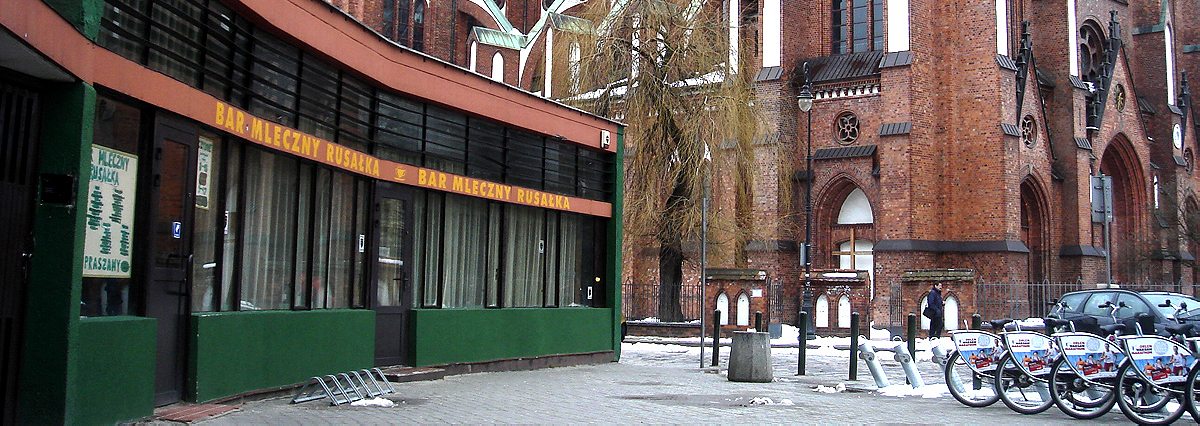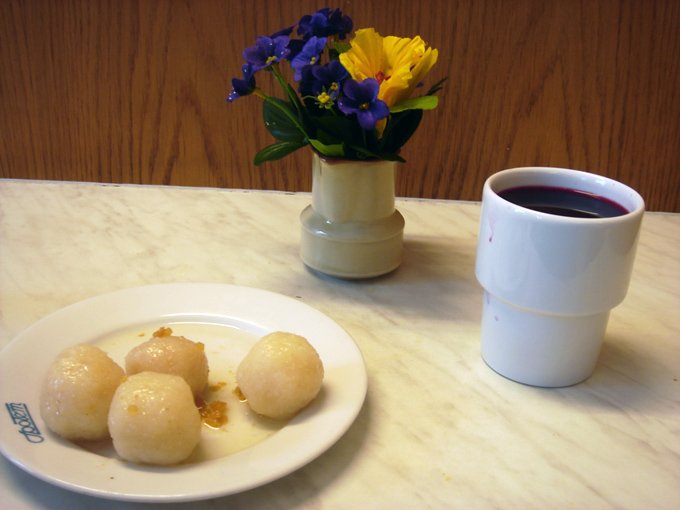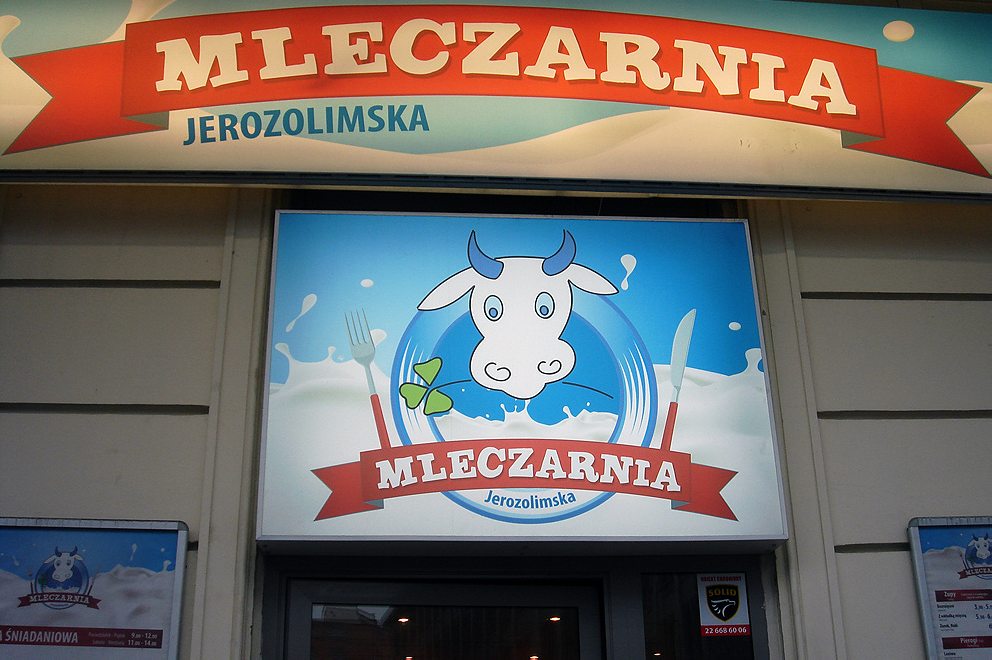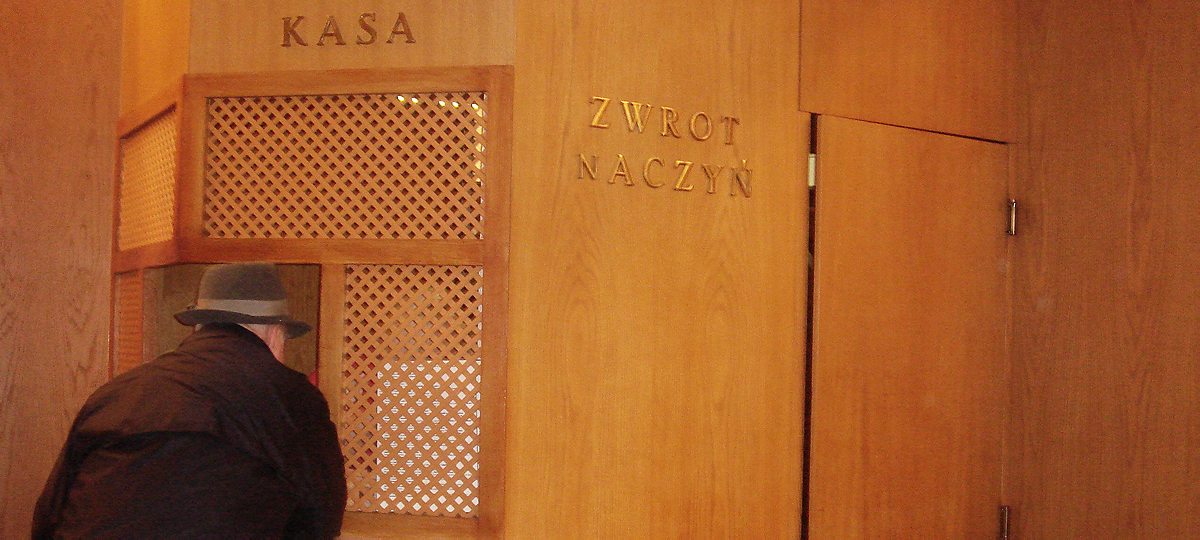A nostalgic tour of Warsaw’s milk bars, the communist-era eateries that are struggling to find their place in the new, posh Poland.
The cutlery hangs on chains. The plates are screwed onto the tables to dissuade thieves and down-on-their-luck opportunists. Bossy dinner ladies in polka-dot aprons keep order with a sharp word or a sharper glance. Many of the items on the menu are unavailable. Welcome to the bary mleczne, the iconic Polish milk bars.
Yes, half of that picture is urban myth, popularized by a scene in the 1982 cult film “Miś” about life in Communist-era Poland. But even if they didn’t have forks on chains or bolted-down dishes, milk bars were a very real part of Polish life during the communist era, feeding the people at affordable prices for close to half a century. Milk bars were rough, sweet, cheap, and honest; an institution in those decades when restaurants were few and out of reach to most people.
And now, they’re dying out.

I am not that surprised by this. Warsaw has often had to reinvent itself. Large sweeps of the city were razed during the Second World War, and then rebuilt. After Communism fell in 1989, glass skyscrapers sprouted from the earth. Banks, shopping malls and fast food arrived. I had been going there to visit family since I was a child, and watched as Poland joined NATO and the European Union, and then largely avoided the global financial crisis of 2008, leaving the years of Communism far behind.
Over the last two decades, though, milk bars began disappearing, falling to just a dozen or so in Warsaw. By now it’s a familiar sensation in the city: go looking for that milk bar you remember from your childhood, and you’re likely to find that the door is locked and the windows are boarded. Or that a chain café has already taken its place.
Milk bars have their roots in the urban “dairies”, which featured a lot more retail than working dairies and were popular at the start of the 20th century. But most milk bars date back to the 1950s and 1960s, when Poland was under Communist rule. The low prices—then and now—come from state subsidies for basic ingredients like dairy products, flour and potatoes. (In 2013, almost $7 million from the state budget was allocated to subsidize milk bars across Poland). The menu centers on staple carbohydrates such as pancakes, pierogi and dumplings. Meat dishes are fewer and more expensive, around $2.50 each. For the sweet tooth, there is “milk soup” and pasta topped with sour cream and strawberries. “Cheap and like in preschool”, is how my cousin summed it up.

The menu is displayed on a large board on the wall. If there is no price by an item on the menu, that means it is unavailable today, a not-uncommon occurrence. Order and pay at one window, then pick up your dish immediately at the next. A female voice bellows “One portion tomato soup with pasta!”. Through the service window, you can catch a glimpse of the industrial-style kitchen crammed with stainless steel saucepans. One has chicken soup, another borsch. Pancakes bronze above a blue gas flame. Dinner ladies in neat aprons jump nimbly between the bubbling pans. Mountains of kneaded dough sit on the counters, waiting to be shaped into dumplings of different kinds. An indefinite kitchen smell hangs in the air. And yet, despite the cooked food from breakfast until nightfall, many milk bars feel neat, clean and welcoming.
When it gets busy, it is normal to share a table with strangers. Milk bars help to integrated society, says Jakub, who protested against their closure in Warsaw. “There are fewer and fewer places where people can meet on equal ground—older and younger people, richer and poorer, lecturers and plumbers, pensioners and students”. All of them value a cooked meal. Richer customers share spare change with the poorest clientele, who otherwise could not afford a meal.
Get out, she told him. He complied
By eleven in the morning, the central Warsaw milk bar ‘Bambino’ is filling up for lunch. A young couple stamps in from the snow. “Look, they have most of the items on the menu today”, she says. “That’s because it’s just after Easter”, the man replies, unimpressed. “Let’s take the tripe stew”.
Dwarfed by the spires of the St. Florian’s Cathedral, Rusałka has a different feel. This milk bar’s name means water-nymph. Stepping inside is like diving underwater, as dim light filters through the seaweed-like curtains. The crowd here is simpler, more local. Tea comes served the Polish way, in a glass with a slice of lemon. The tired-looking woman on the till doesn’t want to talk. She reads out my order again, bringing our short conversation to a close. And why not? She lived most of her life in a regime where it was often dangerous to speak.
Once I saw a drunk take on a dinner lady at a local milk bar. There was no apparent reason for his outburst. “You’ve got dirt under your fingernails! Ladies and gentlemen, take a look at what’s serving your food,” he shouted. The dinner lady was a young girl with her blonde hair tied back tightly in a bun. She took a threatening step towards the drunk, her hands on her hips. Get out, she told him. He complied.

There is still a milk bar on Warsaw’s most elegant avenue, ul. Nowy Świat. ‘Familijny’ probably draws more tourists than any other milk bar, but its prices remain among the best in the capital. In its single wood-paneled room, customers eat round little tables topped with plastic flowers, watched over by a wooden crucifix.
Poles believe that milk bars serve healthy food. Yes, it is often topped off with a dollop of cream. But where else can you eat a proper, balanced meal for this price? Milk bars always serve a choice of salads and many of Poland’s iconic soups. I take a pancake with cottage cheese and the sorrel soup (similar to what the Ukrainians call “green borscht”). Together it costs 3.70 złoty, or just over a dollar. A hard-boiled egg rolls in the soup like an eyeball. The soup is a delicacy, because sorrel—a spinach-like herb with a sour taste—is hard to get out of season.
Familijny shares a street with Starbucks and several Polish coffee chains. Nearby there is a dark café that was, they say, a hub for Warsaw’s underground gay community. Its clientele is from a different generation, not the gay men that have come out on TV or in parliament. Behind the darkened windows, middle-aged men in leather jackets sit hunched over shots of vodka, facing the mirror-lined walls. One by one, they toast their own reflections.
Where have the milk bars gone? A university milk bar, fondly called ‘Karaluch’ (cockroach), was replaced by a pseudo-French café. A single pastry there costs more than a two-course meal at the now-defunct milk bar. When ‘Szwajcarski’ closed in 2005, its team of five dinner ladies posed for the last photos in their red check uniforms as a last gesture of solidarity. Many other locales have been all but forgotten. This is Warsaw, where the rent is high and yet some officials believe that milk bars ruin the city’s modern image.
And then there was ‘Prasowy’. This cult milk bar owed its name to a newspaper (prasowy is derived from the word for ‘the press’) that had its offices nearby. The newspaper came and went but the milk bar lived on, in the same place on Marszałkowska Street for close to half a century. But when its last owner retired in 2011, the bar closed down.
Still, Prasowy did not go without putting up a fight. It opened for one last time on December 19, 2011, when a group of young activists entered the milk bar in protest. They brought pots and pans with them, spread out red and white checked tablecloths and topped them with vases of plastic flowers. In the kitchen, they cooked up soup and rolled out savory pancakes with cabbage and mushrooms, and made the other milk bar classics. This sort of Occupy Prasowy crew then opened the doors to the shuttered milk bar and welcomed in locals of all ages. Four hundred people came in all, according to the organizers. Everyone sat down and enjoyed a final meal together in Prasowy’s retro interior. Within a few hours, the police arrived and the activists dispersed.

Tears were shed over Prasowy, but not everyone was equally ardent. “It was easier to get older people involved in defending the milk bar,” says Jakub, who attended the sit-in at Prasowy. “The young people we spoke to on the street seemed too busy earning and spending money”. The activists say that the city authorities favor banks and expensive restaurants, ignoring the needs and wishes of the locals.
The authorities agreed to open a new milk bar in Prasowy’s place, on the condition that it meet the 21st century requirements: diaper changing facilities, wheelchair access, hygiene certifications and WiFi. They said it would open in early 2013. As the snow fell on Warsaw in April, I took a tram down to where Prasowy used to be. I was met by a bare facade. From behind the smudged up windows, a workman in an orange overall looked up at me from his sandwich.
I only recognized it by the familiar black and white floor tiles.
The truth is, Polish food has been there all along, in milk bars
There is, however, a glimmer of hope for the afterlife of Warsaw’s milk bars. Reinvented ‘dairies’ are opening across the city center. They receive state subsidies on food, which makes them technically milk bars. They serve some milk bar dishes like pancakes and are still cheaper than restaurants (slogan of one of the dairies: “We won’t milk you!”). Inside, they have dropped the Communist-era decor in favor of a modern, pastel look. The crowd they draw is equally pastel-colored; office workers and mothers with toddlers.
Ola, a smartly-dressed and thoughtful Warsaw teenager, chose to write her high school project on the new generation of milk bars. When we meet, she describes how popular they are with her classmates, who consider them “vintage” (evidently a high form of praise in gogo Warsaw). For them, it’s not just a place for subsidised soup, but for iPads and proper coffee as well.
“Nowadays, the best Polish restaurants serve Polish food”, wrote Anne Applebaum recently in the Washington Post. Following a decade of imitation French and Italian restaurants, that seems a welcome development. But the truth is, Polish food has been there all along, in milk bars, with the bossy dinner ladies and the plates that may or may not be bolted to the table.